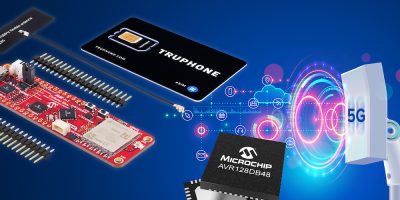Eight-bit MCU development board connects to 5G LTE-M NB-IoT networks
Microchip Technology’s AVR-IoT cellular mini development board is the latest to join its ABR family. It is based on the AVR128DB48 eight-bit microcontroller (MCU). It provides a platform to start building sensor and actuator nodes on 5G narrowband IoT (NB-IoT) networks.
The small form factor board aimed at developers who want to connect IoT devices to an available 5G network. This is an essential feature for devices on the go or located in remote areas with limited availability of long range (LoRa) networks or other low power wide area networks (LPWAN).
The AVR128DB48 eight-bit MCU family includes security protection with Microchip’s ATECC608 CryptoAuthentication device. The ATECC608 can be configured to most major cloud service providers through Microchip’s IoT provisioning tool.
“Microchip continues to expand its family of AVR eight-bit MCUs for developers to implement a variety of embedded designs with ease and flexibility,” said Greg Robinson, vice president of marketing for Microchip’s eight-bit MCU business unit.
The ability to connect remote and mobile devices to a 5G narrowband network with an eight-bit MCU opens up new opportunities for battery-operated devices due to the low power combined with high-quality analogue peripherals, he added.
The AVR-IoT cellular mini development board comes pre-configured to send data from on-board light and temperature sensors to the cloud, viewable using Microchip’s sandbox portal. The sandbox portal lets customers track and monitor their device in real time from a remote location.
This functionality covers the core requirements of many applications in various industries including agriculture, industrial and energy, as well as consumer spaces such as transportation of goods, alarm systems, building automation and remote monitoring.
To provide an easier, more efficient and more cost-effective solution for connecting IoT devices to 5G using the AVR128DB48 MCU, Microchip has partnered with Sequans to include its Monarch 2 GM02S single-chip radio equipped with 5G LTE-M and narrowband IoT. Microchip also partnered with Truphone to provide the SIM card for cellular service that offers coverage worldwide.
The Monarch 2 GM02S is a 5G-ready LTE-M and NB-IoT solution on a single chip, designed specifically for NB-IoT applications, including sensors, wearables and other low data, low power devices. By partnering with Microchip on its AVR-IoT cellular board, Sequans claimed to simplify and lower the costs of IoT device design.
“Owning and operating all elements of the eSIM ecosystem in-house coupled with access to a large number of low-power cellular networks through a single SIM SKU, provides Microchip customers looking to connect IoT devices a future proof cellular service.” said Steve Alder, chief business development officer of Truphone.
The AVR-IoT cellular mini development board fits the Adafruit Feather form factor. It features a Qwiic/Stemma I2C connector for easy functionality extension, creating a clear path to production. It is also Arduino-compatible and is supported by Microchip’s Github Library, which provides functionality for HTTPS, MQ telemetry transport (MQTT), and low power.
Users can access the Microchip sandbox page for a tutorial on how to get up and running and establish a connection with the AVR-IoT cellular mini development board.
Microchip Technology provides smart, connected and secure embedded control, serving more than 120,000 customers across the industrial, automotive, consumer, aerospace and defence, communications and computing markets. Headquartered in Chandler, Arizona, Microchip offers technical support along with dependable delivery and quality.




